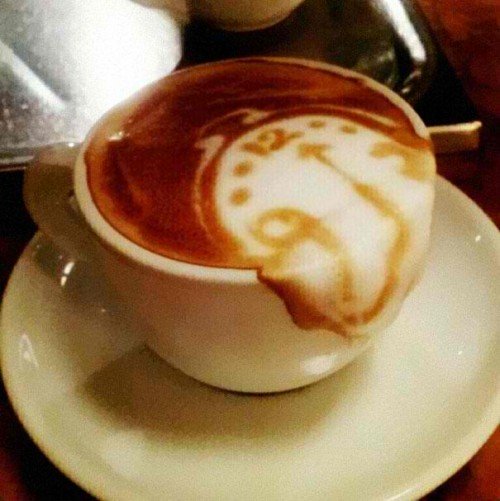 Sunshine peeking through rain clouds this early Tuesday on California’s north coast, and according to the NWS, another high pressure off the shoreline will bring gradual warming for a few days, and supposedly nice weather through the end of next week.
Sunshine peeking through rain clouds this early Tuesday on California’s north coast, and according to the NWS, another high pressure off the shoreline will bring gradual warming for a few days, and supposedly nice weather through the end of next week.
One thing I really, really have grown to hate with my morning coffee is the immediate news of dastardly, asshole terrorist attacks, this time in Brussels, Belgium, where two explosions have killed nearly three dozen people, injuring scores more — and The Donald’s crazed response: ‘“…we’re having problems with the Muslims.”‘
Meanwhile, let’s turn back to the coffee…
(Illustration: ‘Surrealist Cup,’ by Japanese Latte Artist Kazuki Yamamoto, found here).
Similar to marijuana, coffee in recent years has revealed itself as more than just a jump-start mechanism, but also carries a shitload of health benefits, from aiding Type 2 diabetes, decreasing risk of chronic liver disease, even combating Multiple sclerosis.
And for an old asshole like me with an already-diseased brain, and whatever-sized future — one study reported that ‘“…moderate daily consumption of caffeinated coffee appear[ed] to be the best dietary option for long-term protection against Alzheimer’s memory loss.”‘
Good news, I think…
Coffee has grown beyond just the stimulate to accommodate a wide circle of situations — as I said, much like pot.
A good overview of the java juice from Bloomberg last week:
“In many ways, it is the drug of work,” says Stephen Braun, a medical writer and author of Buss: The Science and Lore of Alcohol and Caffeine.
“When caffeine was first introduced to Europe in the late 17th century, it was seen by business owners as a miracle drug that turned formerly dozy workers into productive cogs in the industrial machine.”
And this I discovered years ago, but didn’t really know if true:
It may sound counterintuitive, but caffeine, which made its name as an accessory to sleepless nights, actually works best when you’ve had some rest.
This comes down to the drug’s chemistry: Caffeine mimicks the shape of a naturally occurring brain chemical called adenosine, which Braun compares to an internal “brake pedal” that allows us to turn off and fall asleep.
By essentially clogging our adenosine receptors, caffeine plays defense for stimulating brain chemicals such as dopamine, allowing them to work without the crank-down effects of adenosine.
But caffeine won’t do as much for you if you’re so tired that the chemicals it’s clearing the way for are already depleted.
“Caffeine will work best when you already have high levels of these accelerants, like when you’ve had a good night’s sleep or had a nap,” Braun says.
“If you’re really sleep-deprived, you won’t get the full benefit of caffeine.”
…
The more researchers look into caffeine, the more benefits they seem to find. And they’re only now beginning to understand the drug’s wide range of effects and possible uses.
“This is such a broad spectrum drug,” Braun says.
“Other stimulants are more surgical in their effects. But caffeine is working with the adenosine system, which is all over the freaking brain, so it’s not surprising that you see effects with things like creativity, typing speed, data processing speed, and mathematical computation.”
Now two cups to the good, maybe I can face the double horrors this morning — Brussels, and The Donald…